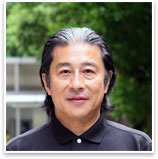George Kunihiro, FAIA
 by John Gendall
Summary: An excellent architect and noted educator as a colleague of AIA Gold Medalist Tadao Ando, George Kunihiro, FAIA, is making his greatest mark on the profession through his organizational skills, bringing together the Japanese Institute of Architects, International Union of Architects, and AIA.
In his bestselling book Linked, author Malcolm Gladwell describes a type of person he calls “Connectors”—people who, because of a natural knack for connecting, can quickly coalesce a broad social or professional network. This is the principle behind “Six Degrees of Kevin Bacon,” the game whose premise is based on the idea that Bacon’s network is so intertwined that no actor is more than six relationships removed from him. The architectural equivalent just might be George Kunihiro, FAIA, a Japanese-American architect who, since 1997, has lived and practiced in his native Japan and who, for the last three years, has spearheaded the Japan chapter of the AIA.
Born to Japanese-American parents residing in Japan, Kunihiro soon moved with his family first to Michigan, then to California, ultimately staying in the U.S. for the next 33 years. He went to the University of California Berkeley to study architecture, receiving a B.A. in 1974, before going to Harvard University’s Graduate School of Design, where, in 1976, he earned his M.Arch. After a stint traveling the U.S. with Tadao Ando as his translator and teaching collaborator, Kunihiro established a Los Angeles-based practice, which he later moved to New York. “I was in my mid-40s and I really wanted to be in Asia, to work in Japan,” he explains. So, as he puts it, “I closed my New York practice, packed up, and left for Japan.” In the 12 years that have elapsed, he has become a valuable contribution to the architectural culture in the region.
Though Kunihiro maintains a three- to four-person design firm, taking on residential and small commercial projects, much of his contribution lies outside of practice itself. He is a professor of architecture at Kokushikan University, where he also heads the graduate program. In the classroom, he advises thesis students and teaches a popular course in comparative history that addresses global architectural Modernism.
His work with professional organizations, though, is where he devotes much of his energy. This year, the AIA inducted Kunihiro into its College of Fellows, citing his accomplishments in professional service overseas. He went to the AIA National Convention in San Francisco this year to attend the investiture. “It was a great experience to go back for the meeting, since I lived there growing up. It was really significant.”
Kunihiro was able to build his service to the AIA on his significant experience with Asian architectural organizations. He has had longstanding participation, for instance, in the Japan Institute of Architects (JIA) and, in 2007, served as its vice president. From 2002-2008, he was a deputy council member of the International Union of Architects. He has been closely engaged with the Architects Regional Council of Asia (ARCASIA) for over 10 years and acts as the vice chairman of the Modern Asian Architecture Network (mAAN). He additionally serves as a nominator for the Aga Khan Award for Architecture.
So, when the AIA launched a Japanese chapter over three years ago, Kunihiro quickly responded, drawing on his past experience to help get the young chapter off the ground. “It was a good match because I had been working with the JIA, so I had been having interactions with the AIA over the years, since the AIA presidents come to the JIA annual meetings.”
“Practice is great,” he says, “but serving the professional community is something I never thought I’d have the chance to do. It’s been very intense, but it has been valuable and satisfying.”
In this capacity, Kunihiro has been able to target issues that affect the region. “We’re taking the environmental issue very seriously. It seems that everywhere is hit with the economic downturn—except China,” he says. “Traditionally, Japanese architects resist working in China, but I’d like my colleagues to look into it.”
“Asia is a really great place for development,” he says. “In many ways, the 21st century is the Asian century. This is a modern place with a lot of development taking place, and a lot of opportunities for international practice.” With his focus on Asia, he always considers American practitioners as collaborators close-at-hand. “We’re right alongside you back at home.”
“I am happy to be an AIA member practicing outside of the U.S.,” states Kunihiro. “It is an honor to be of service as an international practitioner. I can be instrumental to the AIA in delivering information back the U.S., but I can also serve as a representative of the AIA in this part of the world.” Though his efforts are valuable and his role is important, Kunihiro seems to perceive this work as part of a lifelong trend: “Bridging the gap—that’s what I always wanted to do.” |



